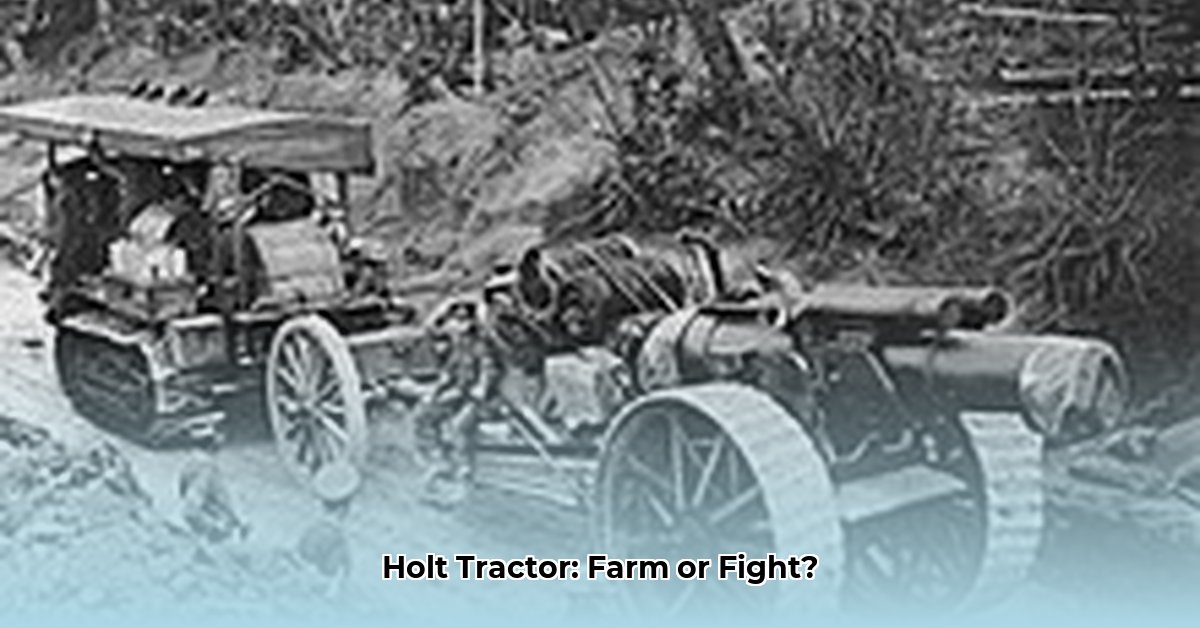
Imagine a world before tractors, a world where farming relied on the backbreaking labor of humans and animals. Then, picture a behemoth of steel and iron, effortlessly traversing muddy fields and rocky hillsides – that's the legacy of the Holt tractor. This groundbreaking invention not only revolutionized agriculture but also played a surprisingly pivotal role in World War I, forever altering the landscapes of both farming and warfare. For more on modern agricultural machinery, see AGCO tractors.
From Oxen to Iron Horses: The Dawn of Mechanized Farming
Before the early 20th century, farming was a grueling endeavor. Farmers depended on animal power for plowing, planting, and harvesting, a process slow, inefficient, and highly vulnerable to unpredictable weather. Benjamin Holt, a visionary inventor, recognized this inherent inefficiency and sought a better solution. His answer? A tractor utilizing continuous tracks instead of wheels. This seemingly small change was revolutionary. Tracks enabled the Holt tractor to navigate terrains — muddy fields, rocky hillsides — that would have hopelessly bogged down wheeled machines. This innovation dramatically increased the amount of arable land, leading to a significant boost in agricultural productivity. Suddenly, land previously deemed unfarmable became accessible, transforming the agricultural landscape.
Did you know that the Holt tractor's impact on food production was so significant it contributed to economic growth and helped feed a growing world population? The increase in efficiency was immediately felt by farmers, enabling them to plant and harvest more, leading to greater yields. The shift from animal power to the Holt tractor represented more than just increased horsepower; it signified a paradigm shift in agricultural practices.
The Holt Tractor: Engineering a Revolution
Holt didn't merely invent the tracked tractor; he continuously refined his design. Several models followed, each building on the success of its predecessors. The Holt 75, a robust workhorse, proved its mettle during the construction of the Los Angeles Aqueduct, effortlessly maneuvering through the challenging terrain of California. Later models, such as the Holt 120 and Holt 60, boasted even greater horsepower and capabilities, becoming indispensable tools for large-scale farming. These tractors could accomplish in a single day what teams of oxen could only manage over several days, and without the need for rest. Their impact was profound, reshaping the very methods of large-scale agriculture.
An Unexpected Battlefield Hero: The Holt Tractor in WWI
The Holt tractor's influence extended far beyond agriculture. World War I presented a pressing logistical challenge: transporting heavy artillery and supplies across the devastated battlefields of Europe. Horses and wagons proved woefully inadequate for the task. Enter the Holt tractor. Its powerful engine and robust tracks, already proven in demanding agricultural settings, proved perfectly suited to the conditions. Imagine the difference: armies could now move heavy weapons with greater speed and reliability than ever before. The Holt tractor became crucial for Allied forces, significantly impacting military logistics and troop movements. While precise numbers are hard to verify due to the war’s chaos, thousands of Holt tractors likely served, playing a significant, often understated, role in the war effort. Their ability to transport munitions had a profound impact on the outcome of battles.
A Legacy Forged in Steel: From Holt to Caterpillar
The Holt tractor’s legacy is far-reaching. Its revolutionary track design fundamentally altered how heavy machinery interacted with terrain, an influence still felt today. The Holt Caterpillar Company, borne from Holt's innovations, continued to advance, eventually merging to form the iconic Caterpillar Inc., a global leader in heavy machinery. The Caterpillar name is a direct lineage from the original Holt tractor, a testament to the enduring impact of Benjamin Holt's vision. The simple yet brilliant concept of tracks instead of wheels revolutionized not only agriculture and warfare but also construction and other heavy industries. Its legacy continues to this day in modern tracked vehicles.
Technical Specifications: A Glimpse into the Machines
While precise historical data is limited and varies, the following provides an approximate overview of the Holt tractor's capabilities:
| Model | Horsepower (Approximate) | Weight (Approximate) | Notable Applications |
|---|---|---|---|
| Holt 75 | 75 | Several tons | Los Angeles Aqueduct, WWI artillery transport |
| Holt 120 | 120 | Several tons | Large-scale farming, WWI logistical support |
| Holt 60 | 60 | Several tons | Agricultural use, potential WWI deployment |
Note: These figures are estimates based on available historical data and may vary.
How Did Holt Tractor Design Influence Early Tank Development?
The Holt tractor's story is intrinsically linked to the development of the tank. Before World War I, armies relied on horses and wagons, a system that proved inadequate for the challenging conditions of trench warfare. The Holt tractor, with its superior mobility provided by continuous tracks, offered a solution to this problem. Its robust construction and high horsepower further enhanced its suitability for military applications.
The British Army, grappling with the limitations of wheeled vehicles in the trenches, recognized the potential of Holt's tracked design for armored combat vehicles. Early tank prototypes often incorporated elements directly borrowed from or inspired by the Holt tractor. This adaptation marked a pivotal moment in military history, leading to the development of the modern tank.
The Holt tractor's reliability and success in diverse applications, from agriculture to wartime logistics, spurred innovation and propelled investment in developing more sophisticated tracked armored fighting vehicles. The legacy of the Holt tractor extends far beyond its initial applications, demonstrating the lasting impact of a single innovative design.